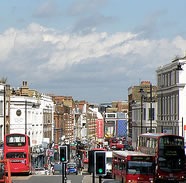New survey shows no significant improvement in pollution since 2011

A new snap shot survey of air pollution in Putney has found that the majority of locations (15/29) tested exceed EU recommended safe levels of nitrogen dioxide (NO2). Levels at eight of the locations have more than 50 per cent over the recommended EU safe level.
The tests which were conducted by the Putney Society show no significant improvement in NO2 levels since a similar survey was undertaken in 2011 despite the introduction of cleaner buses on some Putney routes.

Within the first 8 days of 2016 Putney High Street became the first area in London to breach annual EU NO2 levels and by the end of May there had been over 700 separate breaches compared with 1,443 such occasions for the whole of 2015.
The survey results confirm that local air pollution problems extend beyond the High Street and into nearby main and residential roads.
Levels near some schools in Putney were extremely high: EU levels were breached in three of the six locations tested – in one case, it was almost double the recommended level - and in the other two they were near the limit.
Exposure to NO2 leads initially to respiratory problems but can lead in the longer term to permanent lung damage and heart problems and ultimately a shortened lifespan. In children exposed to poor air, lungs may never develop properly, which is incurable. Air pollution experts at King's College London estimate that the total number of premature deaths from NO2 and particulates is between 3,500 and 9,500 a year in London.
Almost two thirds of NO2 in London’s air according to the Mayor’s Office, come from road transport, almost half of that from diesel engines. Both Transport for London (TfL) and Wandsworth Council have introduced a number of policies to attempt to address the problem. These include TfL’s introduction of more hybrid buses and a plan for an Ultra Low Emission Zone (ULEZ) for central London to reduce pollution to acceptable levels by 2020, while locally Wandsworth Council has developed an air pollution strategy, maintained regular air monitoring in the High Street, lobbied for less polluting buses and restricted day time loading for lorries in Putney High Street.
Judith Chegwidden, Chair of Putney Society said, “Our research confirms unsustainable levels of NO2 throughout Putney. The proposed ULEZ should be extended beyond central London to include areas like Putney where pollution levels are dangerous and unacceptable. We welcome Mayor Khan’s plans to consult on possibly extending the area of the ULEZ to areas inside the North and South Circulars and also consider bringing forward the introduction earlier than 2020."
She continued, "
The proposed ULEZ will need to be tightly controlled. All vehicles breaching EU limits in real road tests, not the laboratory ones, which are too easily cheated, should be banned from the extended ULEZ."
* The map has been created from two data sets:
Nitrogen Dioxide (NO2) concentrations as collected by the Putney Society from 14/02/16 to 20/03/16 using NO2 diffusion tubes. NO2 concentration data has also been ‘normalised’ in line with recommendations from King’s College London
Modelled annual mean NO2 air pollution, based on measurements made during 2010. 2010 is the latest year for which an accurate model is available.
Diffusion tube readings are indicative and represent a snap shot taken over the period.
![]()
June 8, 2016